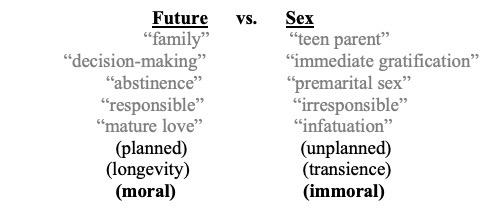Bad Sex vs. No Sex: The Rhetoric of Heteronormative Temporality in Utah’s Abstinence-Based Education
by Nina Feng | Xchanges 16.1, Spring 2021
Contents
History of Abstinence Education in the United States and Utah’s Sex Education
Methods of Queer Linguistics and CDA: The Construction of Heteronormative Temporality
The Introductory PowerPoint: Heteronormative Parameters of Utah’s Sex Education Material
Junior High (JH) and High School (HS) Resource Guides: Heteronormativity vs. “Bad Sex”
Future vs. Sex
The binary of future versus sex becomes clear if we diagram the fractal recursions that spin out of the lexical patterns. Since recursions map the binaries created by discourse, this organization allows us to see the polarizing effect of heteronormative temporal visions of sex. The words in quotations are indicative examples reinforcing the binary headings, and the binary of “consensual versus date rape” is implied in the material, though lexical items do not necessarily support that category.

The main binary is created by the heteronormative emphasis on the absence of sex in the present to establish a future. We can see that the main binary has competing lexical phrases, such as “decision-making” versus “immediate gratification.” In the binary that spins out of “Future,” the categories of “long-term decisions” versus “short-term decisions” reiterates the main binary, repeating the same competing themes such as “responsible,” associated with long-term decisions, versus “irresponsible,” associated with short-term decisions. The same pattern occurs in the binary that spins out of “sex.” “Consensual” versus “rape (date)” repeats the main characteristics of the main binary, with marriage and control associated with consensual sex, and unmarried sex without agency associated with rape. The implications that arise from this structure are that heteronormative timelines, such as the future, are planned, embrace longevity, and most importantly, are moral, absent of present sex. These oppose timelines of the present, which do involve premarital sex, which are unplanned, transient, and most importantly, immoral.

Two realms are created in these three sex education materials. One realm encompasses family, heterosexuality, abstinence-until-marriage, fidelity within marriage, adulthood, and the middle-class. The other realm encompasses "homosexuality," teen parents, immediate gratification, rape, pornography, the working class, and adolescence. Anything that exists outside these realms is backgrounded, erased, and the two realms are reduced to a simplistic battle of good versus evil. Queer identities, BIPOC, and working-class populations are erased. “Safe” sex, even safe heterosexual sex, is erased as well. Since no sex exists in the “future” side of the binary, and sex exists only as a dangerous or violent act/effect in the “sex” side, safe sex is ignored completely.
One sentence describes the act of intercourse in the materials—this is found in the high school resource guide, which emphasizes that the “biological purpose” of sex is reproduction: “the penis is inserted into the female vagina. During this act, the glans of the penis is stimulated which causes the discharge of semen at the time of ejaculation” (USOE HS 42). For students who are not familiar with medical terminology, “glans” may hold no meaning, as well as “stimulated,” which is not explained. Other than this, there is no description for intercourse that involves contraception.
The future, as emphasized by these documents, can only be built in the absence of sex in the present, so premarital sex exists in this curriculum in partnership with fear, disease and unhappiness. The naturalized nature and harmful effects of heteronormative rhetoric are revealed in these documents; in utilizing queer linguistics paired with CDA tools for this analysis, we can begin to understand the timelines and expectations accompanying white, married, middle-class lifestyles, which cast a shadow of deficiency on non-normative actions and related identities. To understand the rhetoric of heteronormativity, we have to understand the rhetoric of absence, which queer linguistics helps us recognize as the obscured presence of marginalized people.
 Download PDF
Download PDF